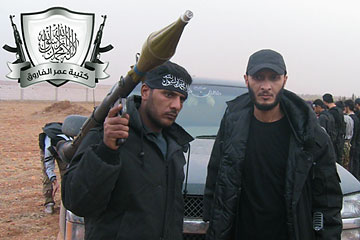
Khalid al-Hamad, left, in an undated photo that originally appeared on the website of the Syrian rebel group, the Independent Omar al-Farouk Brigade, which he commands.
(2 of 6)
Al-Hamad's ceremonial cannibalism provides a glimpse of how grotesquely brutal the Syrian war has become--and a startling example of how technology appears to be fueling that brutality on both sides. War is always cruel, but the savagery on display in Syria, where more than 80,000 have been killed since the rebellion started more than two years ago, far exceeds that of any other recent conflict. The ubiquity of video-equipped camera phones has produced a relentless stream of clips in which ears are sliced off heads, fingers taken from hands as souvenirs, organs removed from torsos--and much, much worse. Soldiers and rebels alike are committing what are plainly war crimes and showing them off on the Internet. Indeed, many of the videos are made expressly for online consumption. "I've seen hundreds of videos like that from both sides," says Rami Abdul Rahman, director of the Syrian Observatory for Human Rights, a U.K.-based independent group that tracks fatalities and abuses in Syria. "It's abnormal. It's inhuman, what is happening."
If the Arab Spring gave the world its first Facebook revolution, Syria is in the throes of the first YouTube war. It's hard to remember now that the anti-Assad movement began in the same vein as the uprisings in Tunisia and Egypt, where cell-phone imagery and social-media platforms were used to inspire and organize peaceful demonstrations that helped topple dictatorial regimes. As Syria's rebellion has morphed into a sectarian civil war, both sides have learned to use these tools for perverse propaganda, apparently goading each other into acts of escalating horror. "An eye for an eye, a tooth for a tooth. Quite a few fighters in Syria interpret that quite literally," says Peter Bouckaert, director of emergencies for Human Rights Watch.
The videos are the handiwork of the extremist fringes, whether of Assad's military or of the rebellion. But they are helping define the conflict as one in which there are no good guys, only combatants of varying shades of villainy. That makes it doubly difficult for outsiders to pick sides. The Obama Administration's reluctance to help arm the rebels is informed at least in part by the fear that weapons may go to the wrong people--people like al-Hamad. "The bestial quality of the [al-Hamad] video confirms the basic proposition that civil wars are usually extraordinarily cruel," says Zbigniew Brzezinski, a former U.S. National Security Adviser, who argues against giving rebels more military assistance. "That justifies caution in labeling one side as democratic and morally preferable and the other as sinful and deserving of extinction, and mitigates against external involvement."
